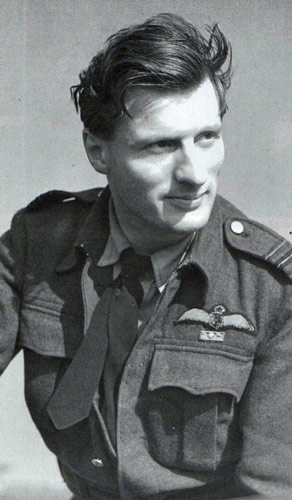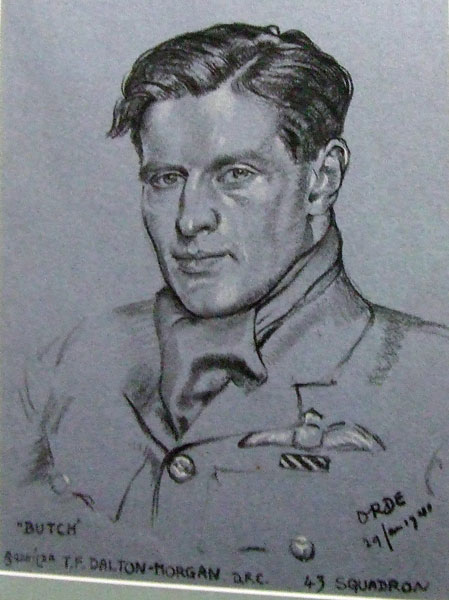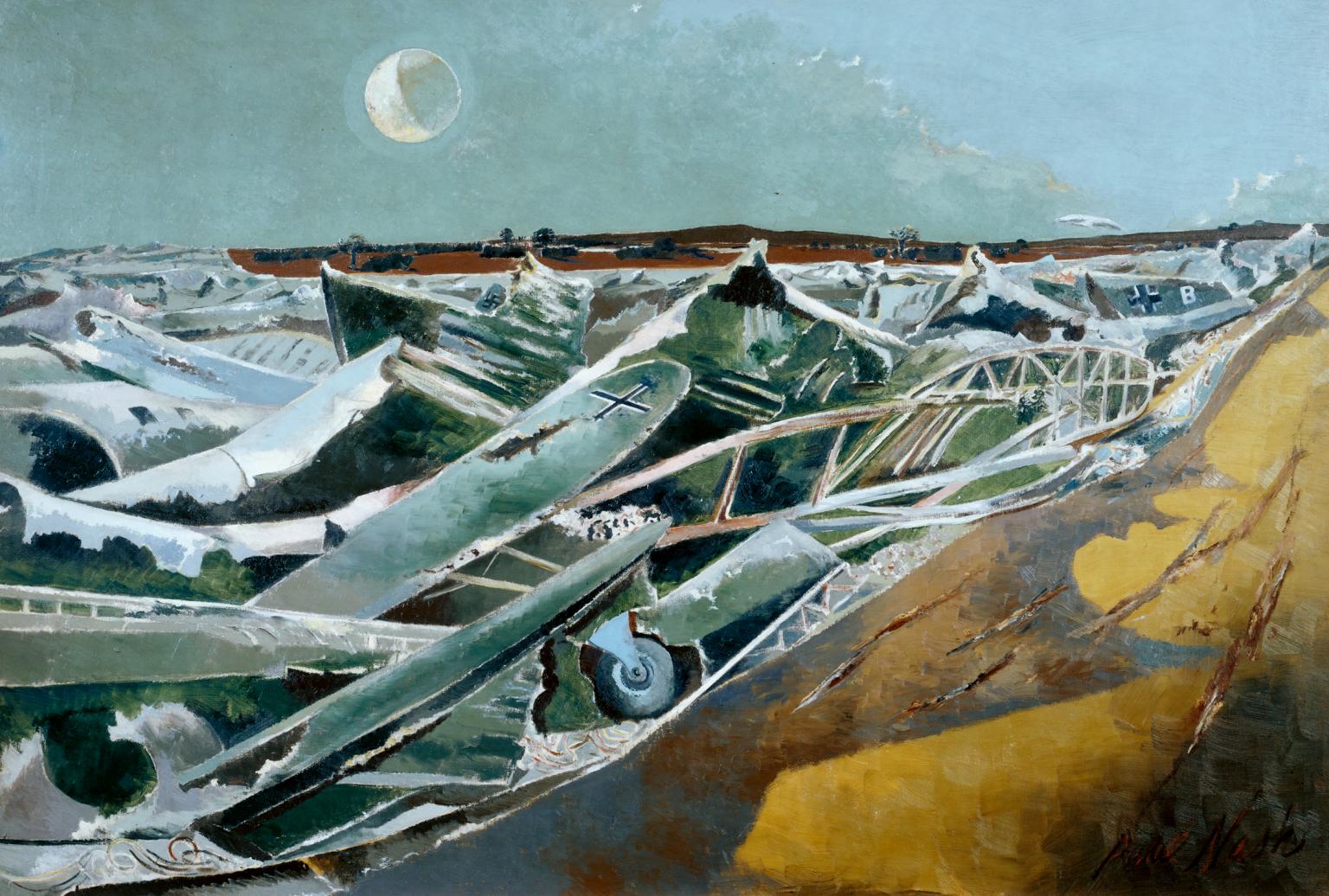DALTON-MORGAN, Thomas F (#306)

#306
Group Captain Thomas F DALTON-MORGAN DSO OBE DFC*
Royal Air Force
23 March 1917 – 18 September 2004
‘a classic example of how a first-class fighter pilot can attack an enemy while his engine is failing,shoot it down, force land on the sea, and get away with it’

‘Group Captain Tom Dalton-Morgan, who has died in Australia aged 87, was one of the RAF’s most distinguished Battle of Britain fighter pilots; he later achieved considerable success during the German night attacks on Glasgow before playing a prominent role in co-ordinating fighter operations for the D-Day landings.
Dalton-Morgan had virtually no experience as a fighter pilot when he was appointed a flight commander of No 43 Squadron – “The Fighting Cocks” – in June 1940. The squadron was flying Hurricanes from Tangmere, near Chichester, and together with others in No 11 Group, bore the brunt of the Luftwaffe attacks.

An Aerial Battle by Francis Dodd (6 September, 1940). “Artist Francis Dodd was born in Holyhead in Anglesey, Wales. He studied at the Glasgow School of Art where he was awarded a travelling scholarship, venturing to France and Italy. He was commissioned as a war artist in both the First and Second World Wars and became a member of the Royal Academy in 1935. He lived in Blackheath, London, until his death in 1949. “a black cat sits on a garden wall seemingly unaware of the recent aerial dogfight which has taken place in the skies above. The aircraft themselves are not visible but their weaving white contrails reveal the tight manoeuvres made between the RAF Fighter Command and German Luftwaffe. Dodd’s scene conveys the simultaneous proximity and distance of the Battle of Britain; aerial combat is evident in the sky but life goes on below. History The RAF pilots who fought during the Battle of Britain were supported by thousands of servicemen and women on the ground. In this painting, numerous barrage balloons are shown floating above the trees. Operated by RAF Balloon Command, barrage balloons were used to protect cities from air attack. They forced German aircraft to operate at higher altitudes, reducing the accuracy of their bombing and bringing them within range of anti-aircraft guns.”
He quickly established himself as a fearless leader. On July 12, he shared in the destruction of a Heinkel bomber; but he was forced to bale out the following day when he destroyed another and then was hit by crossfire. With no badges of rank in evidence – he was wearing pyjamas under his flying suit – he was “captured” by a bobby who placed him in the cells along with the German bomber crew he had just shot down.
Despite being slightly wounded, Dalton-Morgan was soon back in action, accounting for four more enemy aircraft in the next three weeks. In early September, he shot down three Messerschmitt fighters. After one engagement he was wounded in the face and knee, and had to crash-land. His DFC praised him for “displaying great courage when his behaviour in action has been an inspiration to his flight”.
Despite his wounds, Dalton-Morgan returned to take command of the depleted squadron after the death of the CO, and took it to Northumberland to train replacement pilots.

Back Them Up! © IWM Art.IWM PST 14799
A descendant of the buccaneer Sir Henry Morgan and the Cromwellian general Sir Thomas Morgan, Thomas Frederick Dalton-Morgan was born on March 23 1917 at Cardiff and educated at Taunton School. He joined the RAF on a short service commission in 1935, and trained as a pilot.
Following service with No 22 Squadron, flying the Vildebeeste torpedo bomber, he joined the training staff at the Air Ministry. In April 1940 he applied to return to flying, and was appointed to No 43.
“He had an awesome charisma; some sort of special aura seemed to surround him. He was the epitome of leadership, he was a born leader.”
After the Battle of Britain, Dalton-Morgan’s primary task was to train new pilots for service with the squadrons in the south. He was also required to establish a night-fighting capability with the Hurricane; a task he achieved with great success. Few enemy night bombers fell victim to single-seat fighter pilots, but Dalton-Morgan, hunting alone, destroyed no fewer than six.

Totes Meer (Dead Sea) 1940-1 Paul Nash 1889-1946 Presented by the War Artists Advisory Committee 1946 “This painting, the title of which is German for ‘dead sea’, was made during the first half of the Second World War. It was inspired by a wrecked aircraft dump at Cowley in Oxfordshire. Nash based the image on photographs he took there. The artist described the sight: ‘The thing looked to me suddenly, like a great inundating sea … the breakers rearing up and crashing on the plain. … nothing moves, it is not water or even ice, it is something static and dead.’ He created an unsettling atmosphere by setting the scene at night and including a solitary owl in flight.” (The Tate Gallery)
Three of his victims went down in successive nights on May 6-7 1941, when the Luftwaffe embarked on a major offensive against the Clydesdale ports and Glasgow. On June 8, Dalton-Morgan achieved a remarkable interception when he shot down a Junkers bomber, having made initial contact by spotting its shadow on the moonlit sea. After two more successes at night, he was carrying out a practice interception on July 24 with a fellow pilot when he saw another Junkers.
Dalton-Morgan gave chase and intercepted it off May Island. Despite his engine failing and fumes filling the cockpit, he attacked the bomber three times. He had just watched it hit the sea when his engine stopped. Too low to bale out, he made a masterly landing on the water, but lost two front teeth when his face hit the gun sight. He clambered into his dinghy before being rescued by the Navy.
 His station commander, Wing Commander H Eeles, commented: “I consider this to be a classic example of how a first-class fighter pilot can attack an enemy while his engine is failing, shoot it down, force land on the sea, and get away with it.” Dalton-Morgan was awarded a Bar to his DFC “for his exceptional skill”. He scored another night victory on October 2, off Berwick-on-Tweed. Finally, in February 1942, after 18 months in command, the longest spell by any of No 43’s wartime commanding officers, Dalton-Morgan was rested, having shot down at least 14 aircraft and damaged others.
His station commander, Wing Commander H Eeles, commented: “I consider this to be a classic example of how a first-class fighter pilot can attack an enemy while his engine is failing, shoot it down, force land on the sea, and get away with it.” Dalton-Morgan was awarded a Bar to his DFC “for his exceptional skill”. He scored another night victory on October 2, off Berwick-on-Tweed. Finally, in February 1942, after 18 months in command, the longest spell by any of No 43’s wartime commanding officers, Dalton-Morgan was rested, having shot down at least 14 aircraft and damaged others.
After a spell as a fighter controller at Turnhouse, near Edinburgh, he returned to operations in late 1942 to become leader of the Ibsley Wing. Here he had eight fighter squadrons under him, with the task of mounting long-range offensive sorties over northern France and providing scouts for the tactical bomber squadrons. After damaging an Me 109 in December, he shot down a Focke Wulf 190 fighter and damaged another during a sweep over Brest. He was awarded the DSO in May 1943, which recorded his victories at the time as 17.
His experience of escort operations led to his being attached to the 4th Fighter Group of the US 8th Air Force, which was just beginning long-range bomber escort work. He flew more than 70 combat sorties with the group. Promoted group captain early in 1944, he served as operations officer with the 2nd Tactical Air Force.
For a period he worked on an air-to-ground fighter control system with Major John Profumo, whom he rated as the most capable and generous Army officer he had met.
Dalton-Morgan engaged in planning fighter and ground attack operations in support of the campaign in Normandy, then moved to the mainland with his organisation after the invasion. Years after, his CO at the time (later Air Marshal Sir Fred Rosier [Signatory 17]) commented: “It would be impossible to overstate Tom D-M’s importance and influence on the conduct of fighter operations for and beyond D-Day”.
A month before the end of the war in Europe, Dalton-Morgan learned that his only brother, John, who also had the DFC, had been shot down and killed flying a Mosquito. Dalton-Morgan remained in Germany with 2nd Tactical Air Force after the war before attending the RAF Staff College, and becoming a senior instructor at the School of Land/Air Warfare. Later he commanded the Gutersloh Wing, flying Vampire jets, before taking command of RAF Wunsdorf.
 On leaving the service in 1952, Dalton-Morgan joined the UK/Australian Joint Project, at Woomera, where he managed the weapons range for the next 30 years before retiring in Australia.
On leaving the service in 1952, Dalton-Morgan joined the UK/Australian Joint Project, at Woomera, where he managed the weapons range for the next 30 years before retiring in Australia.
He made regular trips home to visit the missile testing range at Aberporth, to see his family and to attend service reunions. He was a vice-president of the Hawker Hurricane Society.
Dalton-Morgan was recognised as one of the RAF’s finest fighter leaders. Slightly scarred by his wounds, he had the dashing good looks of the archetypal fighter pilot, and always attracted the greatest admiration from his air and ground crews. In an article on leadership written after the war, one of Dalton-Morgan’s former pilots wrote: “He had an awesome charisma; some sort of special aura seemed to surround him. He was the epitome of leadership, he was a born leader.”
He was appointed OBE in 1945 and mentioned in dispatches in 1946, the year President Harry Truman awarded him the US Bronze Star.
Tom Dalton-Morgan died on September 18, the eve of the annual Battle of Britain Anniversary service at Westminster Abbey, which he had hoped to attend.
His first marriage in 1939 ended in divorce. In 1952 he married Dee Yeomans who had been widowed during the war. She and their six children, together with a son and daughter from his first marriage, survive him.’ (Obituary courtesy of The Daily Telegraph)
Alan Pollock’s notes:
“Tom Morgan is a name to conjure with. Ace fighter pilot, Wing Leader, brilliant planner and staff officer, widely known and respected throughout the Royal Air Force before and during WWII and subsequently in the high-level civilian posts he occupied. His autobiography (co-authored with Clive Williams) is the fascinating story of a man whom I believed would rise to become the Chief of Air Staff”.
‘306 Gp Capt Thomas F DALTON-MORGAN DSO OBE DFC* was born in Cardiff in 1917 and joined the RAF with a short service commission in August 1935 and after his flying training was posted to 22 Squadron, on Vildebeeste torpedo bombers, before joining the Directorate of Training at the Air Ministry. In June 1940 Tom was posted to Tangmere as ‘B’ Flight commander with 43 Squadron, flying HURRICANES, during the BATTLE of BRITAIN scoring his first victory on 12 July. In action over the Channel in August he was hit by crossfire, baling out with slight wounds. He soon resumed flying but was again wounded on 6 September. Ten days later he was promoted to command 43 Squadron after the recently appointed Sqn Ldr Caesar Hull DFC [c.f. Mrs Margaret BLYTH née Hull, Signatory 6] was killed. No. 43 (F) Sqn, rather battered by the heavy losses, was withdrawn to the north to recoup. Tom’s long tenure as OC of the squadron demonstrated his skills as an operational fighter leader (second DFC and with several important night victories still on Hurricanes) and squadron commander with many different nationalities coming through the squadron, at times more like an operational conversion unit. On their leaving, several would become well known fighter leaders in turn. In January 1942 he left the squadron to become a Controller at Turnhouse and was later promoted Wing Commander Operations with 13 Group. Next he would lead the IBSLEY WING, consisting of four Spitfire, two Whirlwind and two Mustang Squadrons. His victory in May 1943 brought his score to 17 and a DSO. With experience on long range escort he was unofficially attached to the USAAF 4th Fighter Group and had certain other victories, when he was also promoted Group Captain and became a key Fighter Planning and Operations Officer reporting directly to AM Arthur “Mary” Coningham C-in-C 2nd Tactical Air Force for the NORMANDY INVASION and in Europe until the end of the war, with the value of his work being reflected in his OBE in June 1945. Beyond the war, after time in Germany, Staff College and being Chief Instructor at Old Sarum’s Offensive Support Wing, he saw the predecessor of NATO at the Western Union Defence Organisation before leading the Gűtersloh Vampire Wing and being re-promoted back to Gp Capt as Station Commander at Wunstorf. After leaving the RAF, he became heavily involved for many years with missile development at Woomera in Australia and would recount that at one time three Welshmen were respectively in charge of firstly the White Sands facility in the United States, secondly Aberporth in Wales, and he himself at Woomera. Air Cdre Peter Brothers CBE DSO DFC*, who died in December 2008, had described Tom as follows: “Tom Morgan is a name to conjure with. Ace fighter pilot, Wing Leader, brilliant planner and staff officer, widely known and respected throughout the Royal Air Force before and during WWII and subsequently in the high-level civilian posts he occupied. His autobiography (co-authored with Clive Williams) is the fascinating story of a man whom I believed would rise to become the Chief of Air Staff”. (ARP)
Tangmere Military Aviation Museum



